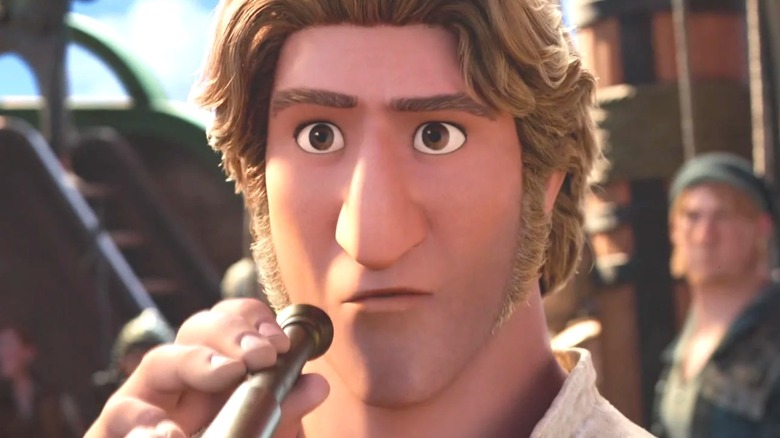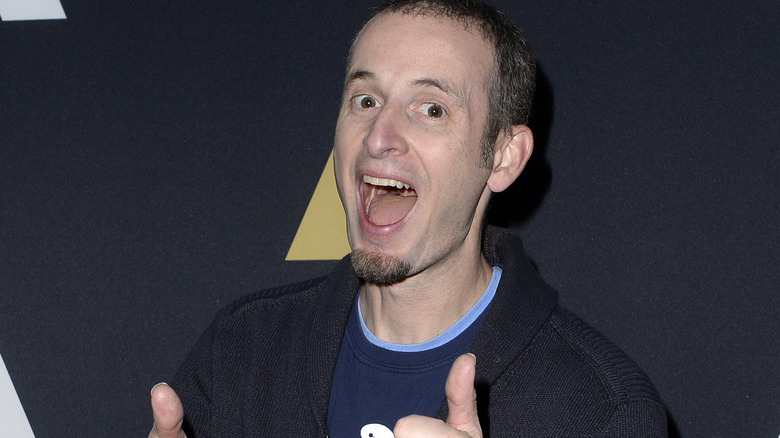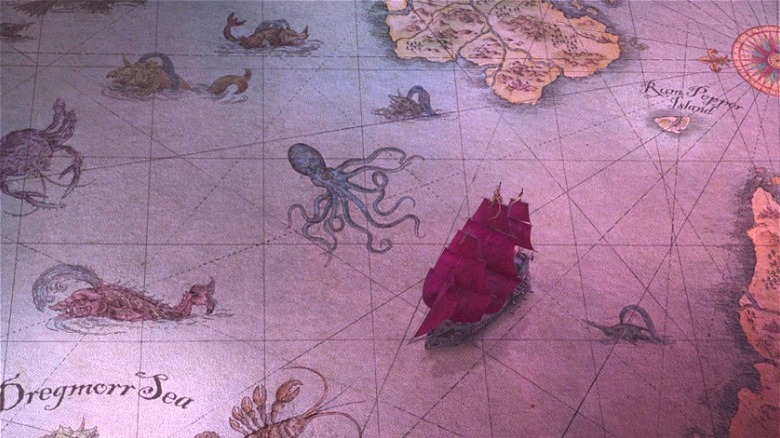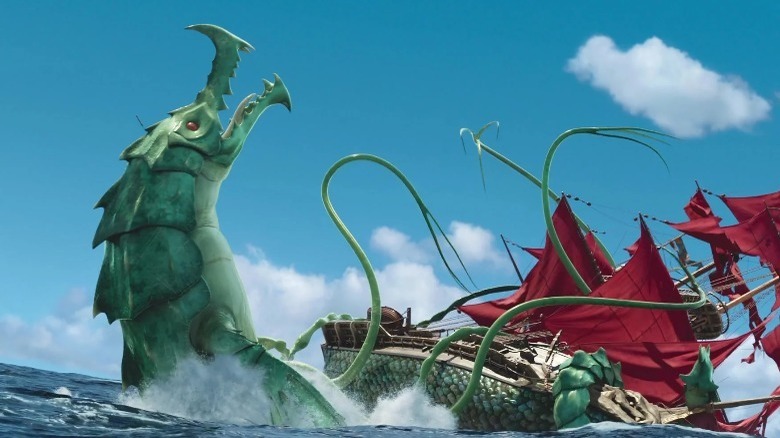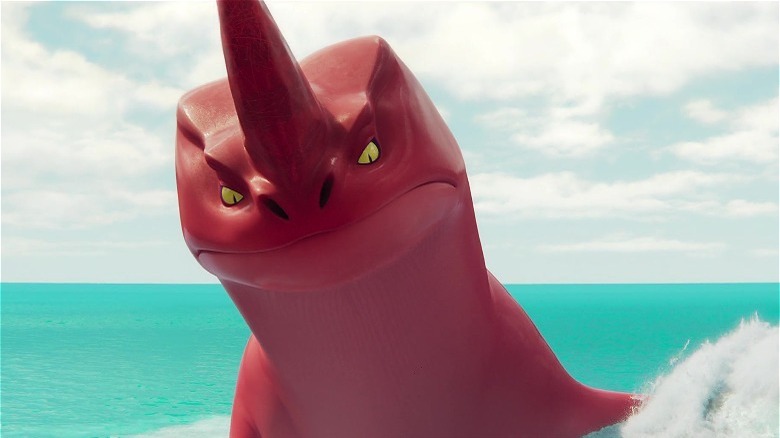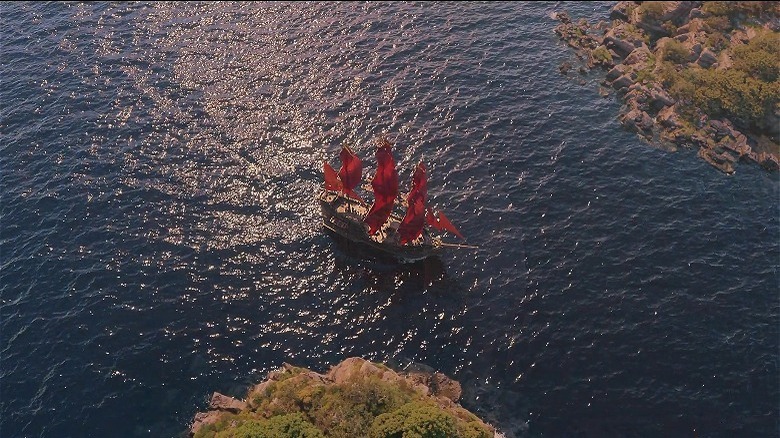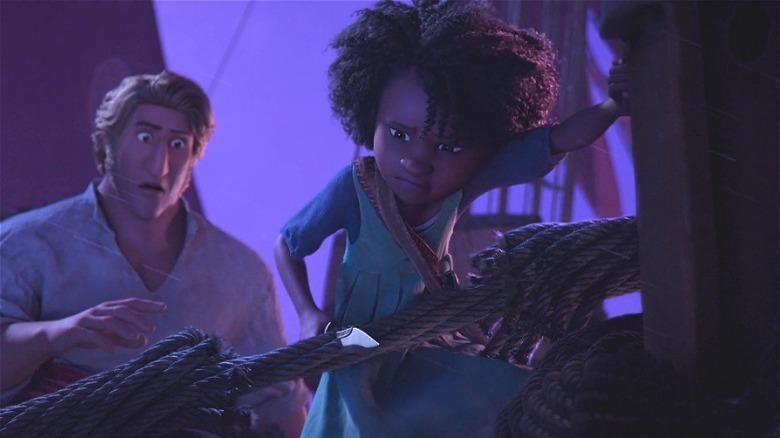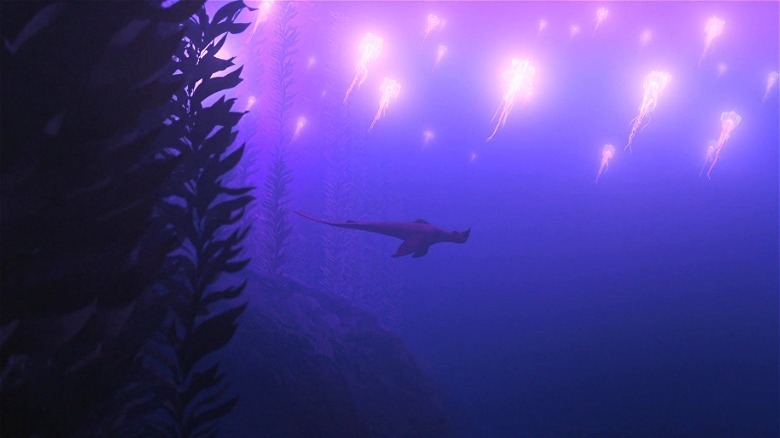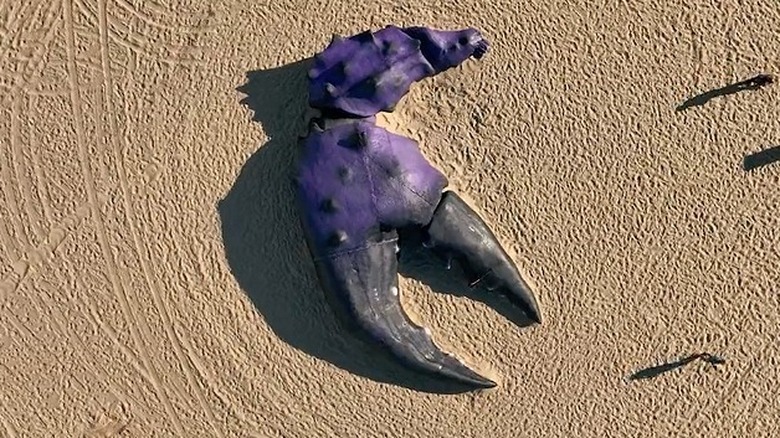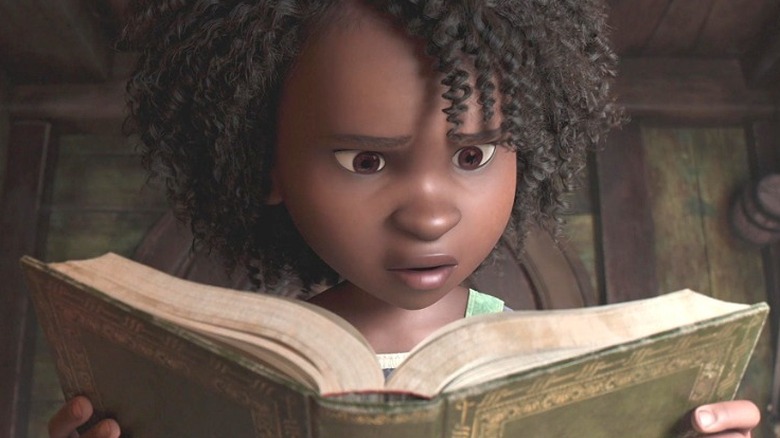The Untold Truth Of Netflix's The Sea Beast
Family audiences everywhere are talking about Netflix's newest animated adventure, "The Sea Beast," and for good reason. Directed by Disney alumnus Chris Williams, the movie stars Karl Urban and Zaris-Angel Harris as the voices of Jacob Holland and Maisie Brumble, two unlikely heroes who befriend a fearsome sea monster.
"The Sea Beast" takes place during a time of war, as brave sea-faring hunters go up against the beasts of the deep in epic battles within the fictional land of Three Bridges. The most famous of hunters, Captain Crow of the Inevitable (voiced by Jared Harris), is determined to put down the great Red Bluster, the fiercest beast of them all. When the audacious orphan girl Maisie stows onto the ship in the hopes of becoming a hunter herself, she and the Inevitable's best hunter, Jacob, find themselves on an adventure that tests their bravery and loyalty. Along the way, they discover what it means to be a family, and what truly makes a monster.
Inspired by works such as Ray Harryhausen's "Clash of the Titans" and the legacy of King Kong films, Chris Williams set out to make a high-seas adventure for the ages. Featuring larger-than-life battles at sea and clashes between giant monsters, "The Sea Beast" required a stellar team of artists, special effects wizards, and a lot of nautical know-how to pull it all off. For fans of the film who might be curious as to how "The Sea Beast" came to be, here are some lesser-known behind-the-scenes facts about the film.
Why Chris Williams took The Sea Beast to Netflix
For many filmmakers, Walt Disney Studios is the Mecca of career goals in animation. The Powerhouse of Mouse has ruled the world of animated features for 85 years, and has set the standard for what a successful feature can do. Director and writer of "The Sea Beast" Chris Williams got his start with Disney working as a story artist on films like "Mulan," "The Emperor's New Groove," and "Lilo and Stitch." In 2008, he made his directorial debut with the movie "Bolt" (which he co-directed with Byron Howard), as well as penning the screenplay with writer Dan Fogelman. Williams made great strides with his work, going on to direct "Big Hero 6" in 2014 (earning an Oscar for Best Animated Feature Film), and co-directing 2016's "Moana."
So why, after achieving so much, would Williams bring "The Sea Beast" to Netflix instead of continuing his partnership with Disney? In an interview with Collider, Williams revealed his reasoning for teaming up with the streaming service. After studying animation at Sheridan College in Ontario, Williams relocated to Los Angeles in 1993, where he was quickly picked up by Disney (via Sheridan Newsroom). Williams worked at Disney for 25 years, and though he considers himself "lucky" to have been part of the team, he felt it was time for a change.
"I wanted to make myself uncomfortable," Williams told Collider. "I was very comfortable and treated very well at Disney, but I wanted change for its own sake. I wanted as an artist to challenge myself and throw myself into a very different situation." Williams also claimed that his vision for "The Sea Beast" felt like it was "tonally" different from Disney's style of storytelling, and Netflix felt like a better fit.
Williams got his inspiration for The Sea Beast from old maps
In the early days of sea exploration, much of the world was still a mystery. According to Britannica, European countries such as Portugal, Italy, Spain, France, and England launched expeditions to find the quickest trade routes among these treacherous unknown waters. Famed explorers such as Marco Polo, Christopher Columbus, Vasco de Gama, and Amerigo Vespucci were among the first to discover the best routes to the continents of Africa and South America. Yet as much of these lands were still uncharted by Europeans, their maps would have had plenty of empty spaces. To fill in those spaces, early cartographers would sketch imaginative mythical sea monsters to indicate the mysteries of these yet unexplored areas.
These historic maps, as it turns out, would be a big inspiration for "The Sea Beast." In June 2022, podcaster and film critic Ashley Saunders spoke to Chris Williams and visual effects supervisor Stirling Duguid about the making of the film. During the interview, Williams talked about his love for old maps and how they helped to influence the creation of "The Sea Beast."
"I always loved those old sea monster maps, there's something about them that is just so evocative and romantic," Williams said. "I really liked in particular the maps that were incomplete with areas that would just kind of fade off into nothingness and I found that nothingness to be just so compelling. They would populate those areas with sea monsters and I would look at those maps and I always thought, man, that would make an awesome world for an animated movie, so I made one."
The evolution of the Brickleback's design
One of the greatest challenges for the movie's design team was coming up with the ferocious creatures of the Dregmorr Sea. At the beginning of "The Sea Beast," Captain Crow and the crew of the Inevitable find themselves up against a dangerous foe — the Brickleback, a huge beast with a hard, armor-like shell, powerful tentacles, and a giant maw of razor-sharp teeth. As the hunters shoot arrows and fling harpoons to take down the formidable monster, the Brickleback seems undaunted, and it almost succeeds in capsizing the ship. Luckily, Jacob's quick thinking and Crow's fearless strength manage to take down the Brickleback before it can do any permanent harm.
In a making-of featurette from Netflix, art director Woonyoung Jung described the process of creating the Brickleback and the inspiration for its design. According to Jung, the monster initially had to move through the water like a snake, and so had a serpent-like body. However, this design choice didn't fit the strength and weight that the animators wished to convey, and so the monster was retrofitted to match these traits. "We ended up actually flattening Brickleback horizontally," explained Jung. "Then Brickleback became like an alligator shape." This ended up being a perfect fit for the menacing sea creature, which could not only swim with the flexibility of a serpent, but also skim the surface of the water with its alligator-like agility.
The inspiration for Red came from real-life animals
The titular sea beast of "The Sea Beast" is the Red Bluster, a mammoth-sized creature with a thick, red-colored hide, yellow cat-like eyes, and a giant horn adorning its head. Dubbed "Red" by Maisie, the Bluster is not the ferocious creature that most have presumed her to be. Once Jacob and Maisie learn how to communicate with Red, they form a bond with the beast, who saves them from enemy monsters and allows them to travel the sea on her back. It's also thanks to their newfound friendship that Red is saved by Maisie and Jacob from the King and Queen of Three Bridges, not to mention Captain Crow's wrath.
Where the Brickleback was meant to encapsulate a reptilian likeness, the Red Bluster was designed with more mammalian features in mind. According to Williams, the design team looked at real animals such as sea lions, whales, seals, and walruses to aid in Red's creation (via Polygon). In the rare moments when you can see Red's entire form outside of the water, she does indeed have flipper-like appendages that are similar to these ocean mammals.
Williams also wished for Red to have qualities akin to big wild cats like lions and tigers, who are fiercely protective when threatened, but also have a wise countenance. The result is a creature that is both fearsome and gentle –- a challenging feat in which the animation team succeeded with flying colors.
How the animation team made the water look so real
As the majority of "The Sea Beast" takes place on the high seas, the animation team was presented with a big challenge. Water is notoriously difficult to animate, and (surprise, surprise) the ocean is filled with it. Though director Chris Williams had also worked on the water-centric "Moana," he knew that "The Sea Beast" would be an endeavor as epic as the story of the film itself. So he decided to go to the experts for help.
According to Screen Daily, Williams researched nautical history with the help of historian Gordon Laco. Laco has been a consultant on projects like "Our Flag Means Death," "The New World," and the "Pirates of the Caribbean" films. Williams also went to the Maritime Museum of San Diego to take a look at the HMS Surprise, a replica of an 18th-century Royal Navy frigate that was used in the film "Master and Commander: The Far Side of the World." As for how they made the roiling waves of the movie look so real, it was visual effects supervisor Stirling Duguid who used a real nautical tool to assist in the venture.
"Doing some research, we learned about the Beaufort Scale," Duguid told Ashley Saunders on her podcast. "It's a scale from 0 to 12, calm to a hurricane, that has a relative wind speed, wave height, and wave speed. We landed on a plan that Imageworks would simulate a library of these Beaufort levels." The Beaufort Wind Scale was a method invented by Admiral Francis Beaufort in 1805, and is still used by sailors today (per The National Weather Service).
The ropes were the hardest things to animate
Once the visual effects team of "The Sea Beast" solved the issue of how to animate the water, their next challenge was even more of a hurdle. The hunters' ship, the Inevitable, is an impressive sea vessel that brings to mind the old-school pirate adventures of yore. It was imperative to director Chris Williams and effects artist Stirling Guduid that the Inevitable have an air of both romance and realism. As a model, the filmmakers studied the British Naval ships of the 17th and 18th centuries, some of which could be as large as 100 feet in length and weigh in at 1,000 tons (per Royal Museums Greenwich). Even with a ship of such massive scale, the most difficult part of animating the impressive vessel may come as a surprise.
A ship needs plenty of things to sail smoothly, but none of those things can work without ropes. According to the animation team for "The Sea Beast," the ropes were the biggest challenge to overcome. There are over 5,000 ropes on board the Inevitable, and each of them had to be animated to move independently. Head of animation Joshua Beveridge told IndieWire, "The amount of complicated rope action demanded that we think of a whole new approach. The hardest thing about animating ropes is that they have these complex regions of slack that come and go. So, we completely overhauled our rigs and our approach to ropes altogether." On your next rewatch of "The Sea Beast," be sure to take in the painstaking work put into all of those ropes.
How color played an essential role in The Sea Beast
Any interior designer knows that colors can affect many things, from how much light enters a room to the emotions they invoke. The same is true with movies, and as a visual art form, colors play an important role in setting the mood. "The Sea Beast" utilizes colors in many ways, as production designer Matthias Lechner noted in a Twitter post from Netflix Geeked.
"Colors are strong themes," Lechner said. "Red versus green. The use of yellow for anger and corruption. Moments of pure adventure — where we use crisp blue skies and white clouds. And then there's lavender and magenta — wonder and aspiration." The examples given by Lechner are taken directly from "The Sea Beast," with stills from the film accompanying the post.
One screen capture shows uneasy tones of yellow in the dark hulls within the Inevitable where Captain Crow unleashes his frustration on the crew. Then there's the red and green contrast of a sinking ship set aflame as a young Jacob is awash in the dark green light of the ocean's surface. When Red dives beneath the water to avoid a storm, the mystery of the sea's dark depths takes on a purple hue, as a swarm of jellyfish swim overhead, alight in a bright pink glow. Not only are these colors a visual delight, but they also help to invoke an element of storytelling that is essential to the visual medium of film.
Netflix promoted the movie by building a giant Red near a Los Angeles beach
Netflix has become well known for its over-the-top, theatrical publicity stunts, causing controversy as well as entertainment. Whether it's placing a shrink-wrapped humanoid mannequin at a Santa Monica bus stop to promote "Altered Carbon" (via Fox 11 Los Angeles), or giving "Stranger Things" fans an immersive experience into the Upside Down on the streets of London (as per The Drum), the streaming platform knows how to get the public's attention.
In yet another impressive display, Netflix caused a stir in Los Angeles for a promotional stunt advertising the release of "The Sea Beast." Visitors to the local beach were greeted by the sight of a giant purple crab claw in the sand, as well as signs around the area warning that sea monsters had been sighted nearby. Before long, the sight of a large Red replica could be seen just offshore, its large horned head poking out of the water's surface. The image was a delight and a thrill for fans, as a plane flying overhead carried a banner that read: "Warning: Sea Monsters! Now attacking Venice Beach." Thankfully, no one was harmed by the "sea monster attack," and Netflix managed to capture the event on video and share it on their official Twitter and Facebook pages.
Redditors have interesting theories about how the war started
The main themes that are sprinkled throughout the movie "The Sea Beast" are the dangers of prejudice and propaganda. History is written by the victors, and more often than not, the victors are the ones holding the seat of power. The truth, therefore, is often subjective and difficult to ascertain.
The movie establishes that the war between the beasts and the hunters has been going on for hundreds of years. According to Maisie's favorite book, the war started when the sea monsters began swimming up to shore and attacking the helpless humans on land. However, after befriending the Red Bluster and attempting to save it from the hunters, Maisie makes a surprising discovery. As it turns out, all of the records of the war were published by the royal line. The origin of the war — and the truth of how it began — was likely a fiction concocted by those in power.
So how did the war get started? "The Sea Beast" leaves this open for interpretation, which left room for theorists to make their own hypotheses. One Reddit thread opened the discussion with the question put forward by u/Farinthoughts: "Why did the royalty lie about this? What was in it for them? Me and my sister speculated that it was to open up trade routes [which were] hindered by ships being attacked by [the sea beast] and free passage would make the kingdom rich."
In response, Redditor u/karim12100 added, "You can probably pick any one of the times in history where a country makes up an enemy to distract the people from internal strife." In a different thread, u/kmjulian offered a similar assumption to u/Farinthoughts: "Best guess, expansionism and trade routes sought by the kingdom, had to clear out sea monsters to do so more easily."
